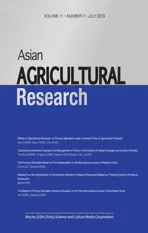Grafting Propagation Techniques of Red Sandalwood (Pterocarpus santalinus), a Precious Hongmu Tree Species
2019-08-23
College of Life Sciences, Zhaoqing University, Zhaoqing 526061, China
Abstract [Objectives]This article aimed to study the grafting propagation techniques of red sandalwood (Pterocarpus santalinus), so as to provide technical support for the effective propagation of seedlings of this precious Hongmu species. [Methods]Based on the analysis and comparison of the growth performance of the Hongmu tree species introduced to China, taking 1 to 2-year-old Pterocarpus indicus seedlings as rootstocks and single-bud stems of P. santalinus as scions, grafting was carried out from January to April using three grafting propagation methods, cut grafting propagation, skin grafting propagation and oblique grafting propagation. [Results]The results of several years of experiments show that in early spring, P. santalinus could be propagated well using the grafting propagation methods of skin grafting propagation and oblique grafting propagation, with survival rate over 80%. For rootstocks with young age or thin stems, the joint unions of the oblique grafting propagation healed well, without apparent protrusions, unlike those of skin grafting propagation. The survival rate of oblique grafting propagation that is fast and reliable was higher than that of cut grafting propagation. [Conclusions]It is feasible to use the grafting propagation methods to propagate P. santalinus seedlings. This is a traditional and innovative technology path in the propagation of high-quality seedlings of precious Hongmu trees, and can be promoted and applied in industrial practice.
Key words Pterocarpus santalinus, Grafting, Oblique grafting propagation, Cut grafting propagation, Skin grafting propagation
1 Introduction
Red sandalwood (Pterocarpussantalinus), belonging toPterocarpusin Papilionaceae, is the world’s most precious Hongmu tree species and excellent landscaping tree species[1-2], mainly produced in Indian state of Mysore and Myanmar. It was introduced to Hainan Island in China through folk channels in the 1950s. The trunk is straight, with strong wind resistance and good growth performance, but has not been valued for a long time[3-5]. Due to the low seed yield and low germination rate,P.santalinusis currently difficult to scale up[6-7]. Studying the efficient propagation technology of seedlings is very important for the introduction and cultivation ofP.santalinusand its industrialization.
Pterocarpusindicusis an important one of the Hongmu species of the genusPterocarpus. It is the earliest introduced and cultivated Hongmu tree species in China. At present, it is cultivated in the vast areas from Sanya, Hainan to Xiamen, Fujian. It has become an important landscaping tree species and precious timber species in the tropical and southern subtropical regions[3, 8]. It has high seed yield, high germination rate, and easy propagation and cultivation. It has no high requirements for the soil, and can still grow well in soil with gravels, coastal sand and even soil with certain salt content. The root system is developed, with root nodules. It grows fast, with strong regenerative capacity, and requires shorter time to grow into large tree. However, the value and cold resistance ofP.indicusare not as good asP.santalinus[9-10].
Grafting is an ancient global plant biotechnology with endless vitality[11-13]. China is recognized as the first country in the world to invent grafting propagation technology. The original purpose of grafting is to carry out vegetative reproduction of plants to give full play to the excellent characteristics of cultivars. Modern grafting techniques are mainly used to improve plant traits. Therefore, grafting is widely used in plant propagation and breeding of new varieties[14-16]. Currently, the heritable variation produced by grafting is one of the hotspots of plant biology research at home and abroad[17-19]. Mr. Qian Xuesen believed that pruning and grafting technology is promising in agriculture and forestry, and the role of a technical science, plant grafting transformation, is no less than genetic engineering[20].
Based on the value, environmental adaptability and seedling reproduction biology ofP.santalinusandP.indicus, grafting technology has been applied to the propagation ofP.santalinussince 2011. The practice in the past few years has proved to be successful. It was found that the grafting ofP.santalinuswithPterocarpusmacrocarpusas rootstock has the effect of promoting the growth of pith and its surrounding tissues and early timbering. In 2016, two technical invention patents were declared to the State Intellectual Property Office[21-22], and the technical article for the latter study was published in February 2018[23]. There has been no report on the grafting propagation ofP.santalinusin foreign countries, so it is China’s technological creation. This article reports on the grafting propagation techniques ofP.santalinuswithP.indicusas rootstock.
2 Materials and Methods
2.1 Test materialsThe test site (112°29′21.41″ E, 23°06′35.95″ N) is located in the Biotechnology Park of Zhaoqing University, 17 m above sea level. It belongs to subtropical monsoon climate, with annual average temperature of 21.9℃, average temperature in January of 12.5℃, average temperature in July of 28.7℃, average annual precipitation of about 1 650 mm (mainly distributed in early spring, summer and autumn affected greatly by typhoon), annual evaporation more than 1 300 mm and annual sunshine hours of 1 815.72 h.
The plant material for grafting is 1 to 2-year-oldP.santalinusseedlings, of which the seeds were introduced from the Hainan Tropical Botanical Garden. WithP.indicusas rootstock and sing-budP.santalinusstem as scion, oblique grafting propagation, cut grafting propagation and skin grafting propagation were carried in out early (January, February) and late (March, April) spring respectively. The graft survival rates and the healing of the graft interfaces of different treatments were studied to screen out the best grafting propagation technique.
2.2 Test methods
2.2.1Oblique grafting propagation. The rootstock was cut at 5-6 cm above the ground and then cut upwards using a grafting knife. The length of the cut surface was 2-3 cm, which was kept smooth. In the same way, the scion was cut obliquely, with length of the cut surface equivalent to that of the rootstock. It was cut into segments, in length of 4-5 cm, with a bud eye in each segment. Then, the rootstock and the scion were aligned with each other. After holding the lower end of the interface with the left thumb, the grafting interface, as well as the entire scion, was bound with plastic film using the right hand. The bud eye was wrapped with only a layer of plastic film to facilitate its sprouting (Fig.1).
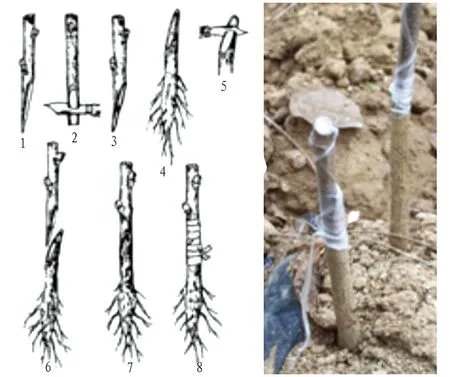
Fig.1 Oblique grafting propagation of red sandalwood (Pterocarpussantalinus)
2.2.2Cut grafting propagation. This method is applicable when rootstock diameter is significantly larger than that of scion. The rootstock was cut perpendicularly to the stem at 5-6 cm above the ground, and the cut surface was kept smooth. In the edge of the cross section, the xylem of the rootstock was cut longitudinally till the cambium, with a depth of 2.5-3.0 cm. The scion was 4-5 cm long, and the base was cut into two slides with one long and the other short (the length of the long shaved surface was equivalent to the depth of the incision). The bud was left on the opposite side of the long shaved surface. The long shaved surface was inserted into the scion of the rootstock, the cambia aligning with each other, and then the rootstock and the scion were tied with a plastic film strip for grafting. Note that the position of the scion should not be moved during operation, and the tie should not be too thick or too tight. Only one layer of film was required at the bud eye (Fig.2).
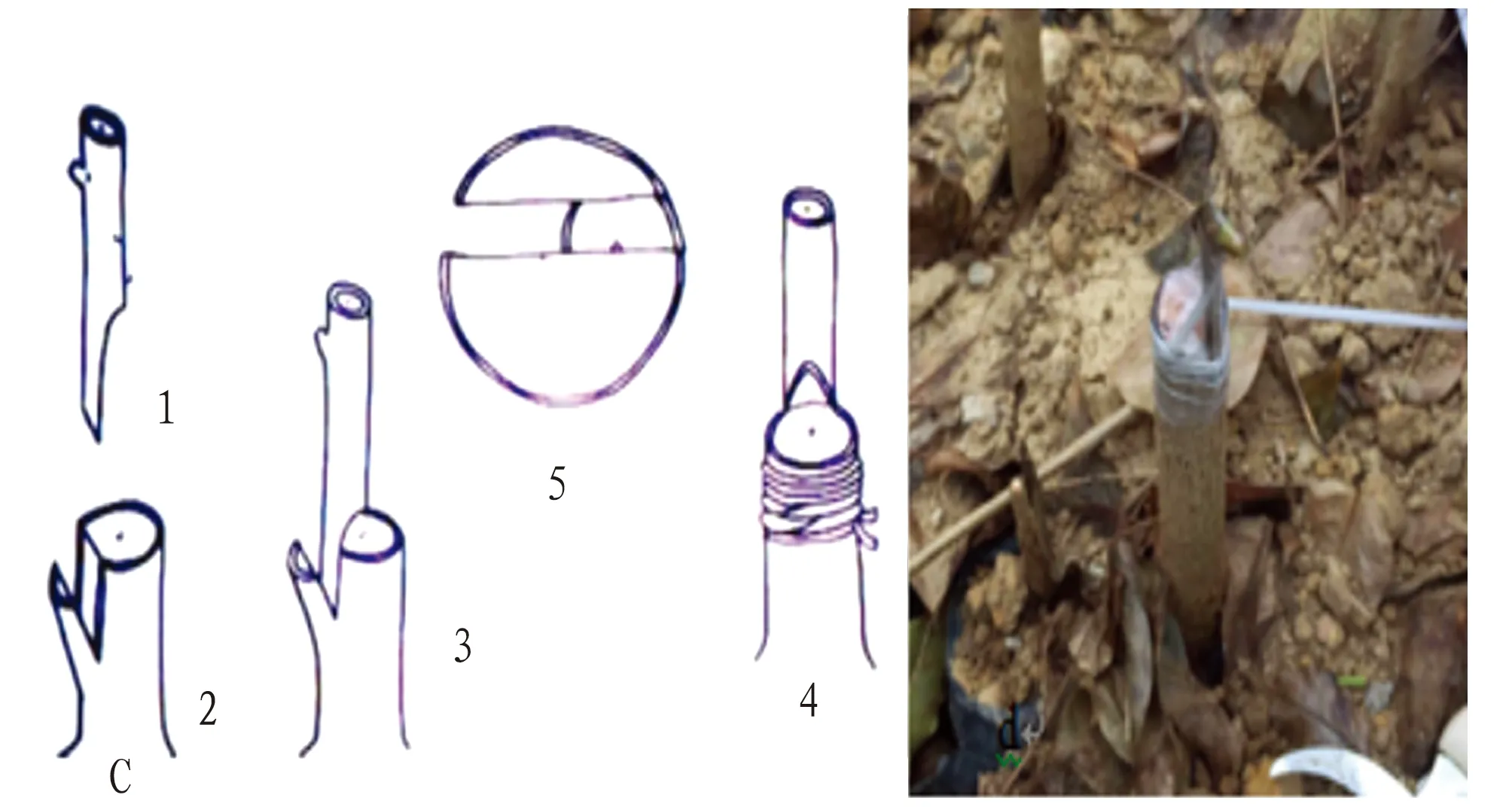
Fig.2 Cut grafting propagation of red sandalwood (Pterocarpussantalinus)
2.2.3Skin grafting propagation. The cutting and grafting methods of the rootstock and the scion were basically the same as the cut grafting propagation. The main difference was as follows. In skin grafting propagation, the portion cut downward from the incision on the rootstock was essentially a phloem rather than a large area of xylem; and more often, the phloem of the rootstock was cut longitudinally using a grafting knife, and the incision was opened slightly using the tip of the knife, and the scion was inserted down to the xylem until it is tight. To promote survival, when the scion was too thick, the phloem was cut off slightly on both sides using the grafting knife (Fig.3).
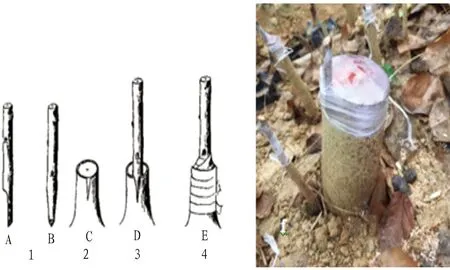
Fig.3 Skin grafting propagation of red sandalwood (Pterocarpussantalinus)
2.3 Management after grafting propagationThe post-grafting management was the same as the general grafting seedlings. For the buds unable to break through the plastic film, artificial aids were provided. The buds sprouted from the base of the rootstock were removed or cut off in time. In mid-June (at least 60 d after grafting), when the performance had stabilized, the survival rate was investigated.
3 Results and Analysis
3.1 Effects of grafting period on survival rateThe results show thatP.santalinusandP.indicushave better affinity. The survival rate of grafting was relatively high. The period of highest survival rate was from January to February in the early spring, with an average of 92.4%. However, the graft survival rate decreased after mid-March, and decreased significantly in April, with reduction around 20 percentage points.P.santalinusandP.indicusare semi-deciduous in winter and spring in Zhaoqing, Guangdong, and sprouts late in spring, especiallyP.santalinus. However, in April, red sap had begun to be produced actively in large amounts. However, the humid environmental conditions in April with more rainfall were unfavorable for the survival of the scions in the open nursery (Table 1).
Table 1 The survival rate of grafting ofPterocarpussantalinusat different periods

3.2 Effects of grafting methods on survival rateThe temperature in the open nursery in Zhaoqing, Guangdong is quite high in mid-April, but in a nursery greenhouse with adjustable temperature,P.santalinusis sprouting at this time, and there are still a considerable number of buds on the branches, which can be used to cut scions for grafting. As shown in Table 1, the average survival rate of the three grafting propagation methods was 70.6%, relatively high. However, the survival rates of different grafting propagation methods were quite different. The survival rate of oblique grafting propagation was the highest, reaching over 90%. The survival rate of skin grafting propagation rank second, about 70%. The survival rate of cut grafting propagation was the lowest, and only half of the scions could survive (Table 2). In addition to the effects of late season and high temperature, it is considered that the equivalent diameter of the rootstock and the scion is the main reasons. In oblique grafting propagation, the relative proportion of the actual grafted area was significantly larger; but in cut grafting propagation, mainly the xylem was cut, and the proportion of the actual grafted area was the lowest.
Table 2 Survival rate ofPterocarpussantalinusgrafted with different grafting propagation methods

3.3 Healing of grafting unionsTaking 1-year-oldP.indicusas rootstock, grafting ofP.santalinuswas carried out for propagation. After 60 d of the grafting, the grafting interfaces of the seedlings grafted by the three methods had been significantly healed, but there were still obvious traces (Fig.4). After 6 months of grafting, although there were still obvious traces of the graft interfaces, they healed completely overall. The growth of the grafted seedlings was good, and the diameter of the scion was basically synchronized with that of the rootstock (Fig.5), further indicating thatP.santalinusandP.indicushave better affinity, and healthy and strong grafted seedlings can be obtained through their grafting. Regardless of grafting propagation method, the healing of grafting interface with thicker rootstock requires a long time, and it is more difficult. If the diameter of the rootstock and the scion differs insignificantly, the graft interface can be completely healthy within one year, with excellent overall quality (Fig.6).
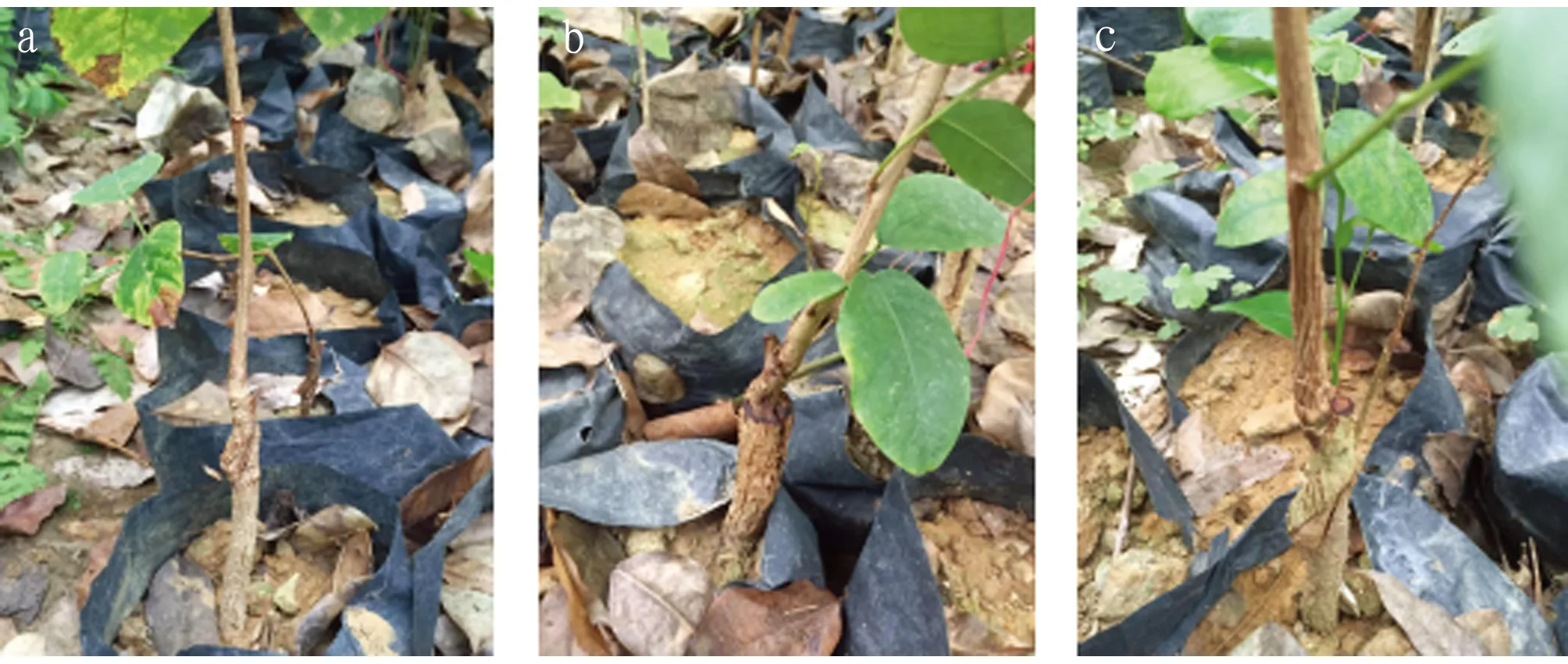
Note: a. oblique grafting propagation; b. cut grafting propagation; c. skin grafting propagation.
Fig.4 Healing status of the interface 60 d after grafting

Note: a. oblique grafting propagation; b. cut grafting propagation; c. skin grafting propagation.
Fig.5 Healing status of the interface 6 months after grafting

Note: a. oblique grafting propagation; b. cut grafting propagation; c. skin grafting propagation.
Fig.6 Healing status of the interface 12 months after grafting
4 Discussions
The increase in grafting efficiency depends on the healing rate of the grafting interface. The healing of grafting interface involves traumatic response, physiological and biochemical processes, cell and tissue differentiation, signal exchange between rootstock and scion and vascular bundle reconnection[24-26]. Therefore, the key to the success of grafting is the affinity of the scion and the rootstock. The survival rate of grafting is an important parameter to evaluate the affinity between scion and rootstock. In general, the chances of successful grafting between closely related plant species will be higher. If the grafting survival rate is very low, even for very precious plant materials, the method itself is also not suitable. According to special experiments in a few years or sporadic grafting practices, whenP.indicusis use as rootstock for propagatingP.santalinus, the affinity between the rootstock and the scion is good, and the method is feasible.
In work practice, it was found that even in mid-May, whenP.indicuswas used as rootstock for grafting in Zhaoqing, Guangdong, the graft survival rate ofP.macrocarpuswas greater than that ofP.santalinus. This may be explained by the strong regeneration ability of the tree species, rather than the stronger affinity with the rootstock. The results of a large number of cutting propagation tests show that regardless of hard branches or twigs, only a small amount of scions inP.santalinuscan survive and root, and the survival rate is very low, confirming thatP.santalinusis a hard-to-root tree species, which should be one of the biological causes for its precious and endangered state. However, whenP.macrocarpusis used as scion, even if the scion is not subjected to any rooting treatment, the survival rate of its hardwood cuttings can still be high even it is already in late April. Rooting of cuttings and calli can both occur, and propagation is easy. A basic study is been conducting on the healing mechanism of the interface in the grafting of Hongmu tree seedlings and the commonality and difference with rooting.
The plant species in different genera are far away. Although there are reports on successful grafting between different genera, but in practice, it is not feasible in general.Dalbergiaodoriferais the only the Hongmu species native to China[27], commonly known as "huanghua pear". Its value of wood (heartwood) is second only toP.santalinus, characterized with easy breeding, wide adaptability and strong resistance. Li Hongguoetal.[28]reported that takingD.odoriferaas the rootstock, 20 plants ofP.santalinuswere grafted, and six of them were survived, considered successful. Based on the excellent traits ofD.odorifera, it was also used as rootstock in the grafting propagation ofP.santalinus. The number was far more than 20, but none of the scions survived in the greenhouse or the open nursery. Later sporadic practices also proved the aforementioned results. It is good to breedP.santalinusseedlings withD.odoriferaas a rootstock, but at least it is not reliable at present.
There are many grafting propagation methods, and there are many variations in the same method, but only that performing well in economics and technology is the best. In this study, three grafting propagation methods were compared with survival rate as the evaluation indicator. As long as the grafting time is not too late, they are suitable for the grafting propagation ofP.santalinusseedlings. However, the oblique grafting propagation is more favorable, characterized with simple and easy operation, high survival rate and better healing. The application of oblique grafting propagation in plants is rare, and this study should be the first report on its application in woody plants. Skin grafting propagation is widely used in South China, with good foundation. When used as rootstock for grafting propagation ofP.santalinusseedlings, the diameter should be moderate. If the diameter is too large, the healing time of the graft interface will be significantly prolonged, which is not suitable for cultivating high-quality seedlings. In this sense, the age of rootstock seedlings can be one year old. Thicker or older rootstock seedlings are a kind of waste.
5 Conclusions
Choosing the appropriate rootstock for grafting propagation has innovated the nursery ofP.santalinus. This study explores a traditional and novel seedling propagation technology forP.santalinus, a precious Hongmu tree species, which has outstanding theoretical and practical significance in cultivation and breeding.
杂志排行
Asian Agricultural Research的其它文章
- Planning, Protection and Construction of Ancient Villages in Jiangxi under the Background of New Urbanization: Taking the Water Management System of Mingkou Village in Leping City, Jiangxi Province as an Example
- Application of Biogas in North China
- Coastal Environmental Changes and Management in China in the Context of Global Changes and Human Activities
- Analysis on Regional Development Model of Rural E-commerce
- Research on the Sustainable Development of Agriculture
- Countermeasures against Prominent Problems of Forestry in Yutian County under the New Normal
